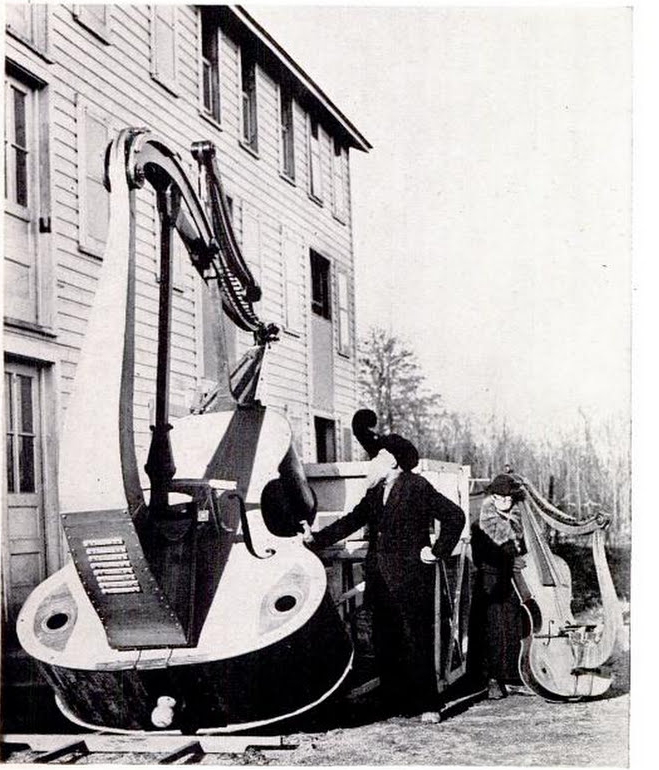Arthur and Bertha Ferris

Original pic here.
Two more pics of Ferris here.
The visionary musical instruments of Arthur Kirk Ferris (b. 1871, Madison, Wisc., d. after 1943, New Jersey) represent one of the most extraordinary chapters of creative instrument building in America. In creative partnership with his wife of over four decades, Bertha Bell Hallock (b. 1870, d. after 1943), the Ferrises together devoted their lives to Christian ideals (of the Seventh Day Adventist variety) and to using music to spread the Word. The couple had no children, arguably a natural consequence of Arthur’s advocacy for immaculate conception.
Bertha was not a composer; she was the chief performer in his ensembles and provided her original contribution during ensemble improvisations. While hymns such as “Rock of Ages” and “Abide with Me” were played by members of the Ferris Celestial Orchestra, they also played “tunes of heavenly inspiration;” a practice followed in this recording. Ferris’s music was played on a New York radio station, featured in Ripley’s Believe It or Not show, and written up in Popular Science in 1938. This is the first time they have been played in over 60 years.
Although none of his written compositions survives, the Ferris spirit is amply contained in the twenty or more string instruments made in the 1920s and ‘30s, a dozen of which are found in the Schubert Club Kugler Collection in Minnesota. Awakening the instruments’ dormant daimons took some clambering around the storage warehouse, dusting, tensioning strings, perpetual retuning, and spiritual preparation (to compensate for our lack of true “Biblical character” so important to Arthur). Yet the other-worldly sonorities and exquisite craftsmanship inspired a sense of awe and devotion, whether or not we succeeded in projecting the particular homilies inscribed inside the soundboards.
Ferris’s Big Fiddle (1924) is listed in the Guinness Book of Records as the largest viol in the world, coming in at over 14 feet tall by 6 feet wide. The lowest tones are inaudible to the human ear (at two octaves lower than the lowest piano tones, the vibrations could only be felt when played inside a barn which acted as a giant resonator). But then humans were not the only audience for his work:
It began at 3 o’clock of an afternoon in 1924. Arthur sat by the window of the farm in Ironia (NJ). There was a mist in the field outside, but as Arthur gazed, it lifted and instead of the usual rocks and grass hummocks his eyes fell upon the strangest sight he had ever seen. Hundreds of harps and fiddles of all sizes lay on the green grass.
“Then,” Arthur’s wife recounts, “a voice spoke to him. ‘I’m Gabriel,’ it said, ‘you write this vision and make it plain that people may run and read it. You make these instruments and show these people that the word of God is true.’”
The “voice” told Arthur how to make the instruments… Arthur’s wife says he is “careful about doing what he is told by the unseen.” [The Sunday Call, Newark, NJ, July 7, 1940]
He spent the next 16 months in the Hudson River State Hospital for the mentally ill (apparently committed there after a spat with a fellow Seventh Day Adventist), and from that time on wrote down his dream visions, often between midnight and 7 am. Some were varnish formulas, some were about the future destruction of New York, a greenhouse design, or a beehive-handling machine, or the necessity of Seventh Day Adventists to dress plainly. Yet others concerned instrument design.
The angels communicated plans for 126 string instruments, many of them hybrids between the violin and the harp families, presumably common in the orchestras of heaven. Being a landscape gardener and holder of a varnish patent (was it the sniffing of varnish that led to his visions?), Ferris was familiar with the characteristics of many local trees and the qualities of their wood. Each instrument uses a combination of woods, chosen as much for the Biblical virtues they represent as for their resonating, visual and structural potential. Each instrument of his Celestial Orchestra was also intended for a particular purpose; they were to play only sacred music (although one was permitted to be played for filthy lucre): one was given to a woman who lived a 100% Christian life for one year before and after marriage, and all had their insides densely inscribed with texts (concerning the visions, the materials used, and the truths that would be manifested by playing the instrument well). Names of the instruments included: Horn of Plenty Harp, Thribble Bass, Liberty Harp, David Loot Harp, Giant Loot Harp, Obedience Harp, Prophetic Loot Harp, Baretone, and Suitcase Viol.
Comments
Viol? Maybe he meant vitriol.
Posted by Virtual on 12/09/16 at 10:54 AM
Also, we need to see the Obedience Harp, to make sure Arthur and Bertha weren't dabbling in S&M.
Posted by Virtual on 12/09/16 at 11:09 AM
The story sounds like something Peter Schickele might have written.
Posted by KDP on 12/09/16 at 01:49 PM
Hmm... reminds me of the Gaffophone.
Posted by Richard Bos on 12/10/16 at 02:51 PM
You can listen to a work played on some of his instruments (Violinetta, Mother Lap Cello Harp, Bridal Lap Harp, and Whispering Harp) here:
https://www.youtube.com/watch?v=zyEO_9hXY9Q
https://www.youtube.com/watch?v=zyEO_9hXY9Q
Posted by ges on 12/10/16 at 06:54 PM
Commenting is not available in this channel entry.



Category: Eccentrics | Music | Nineteenth Century | Twentieth Century